Economic Growth and Policy Framework of Australia (2012-2017)
VerifiedAdded on 2023/06/12
|22
|4241
|145
AI Summary
This report analyses the economic growth of Australia over the last five years (2012-2017), thereby analysing the economic policy framework of the country. The report also tries to discuss the industries which have grown in the country over the years, thereby trying to analyse the reason behind the growth of the concerned industries.
Contribute Materials
Your contribution can guide someone’s learning journey. Share your
documents today.
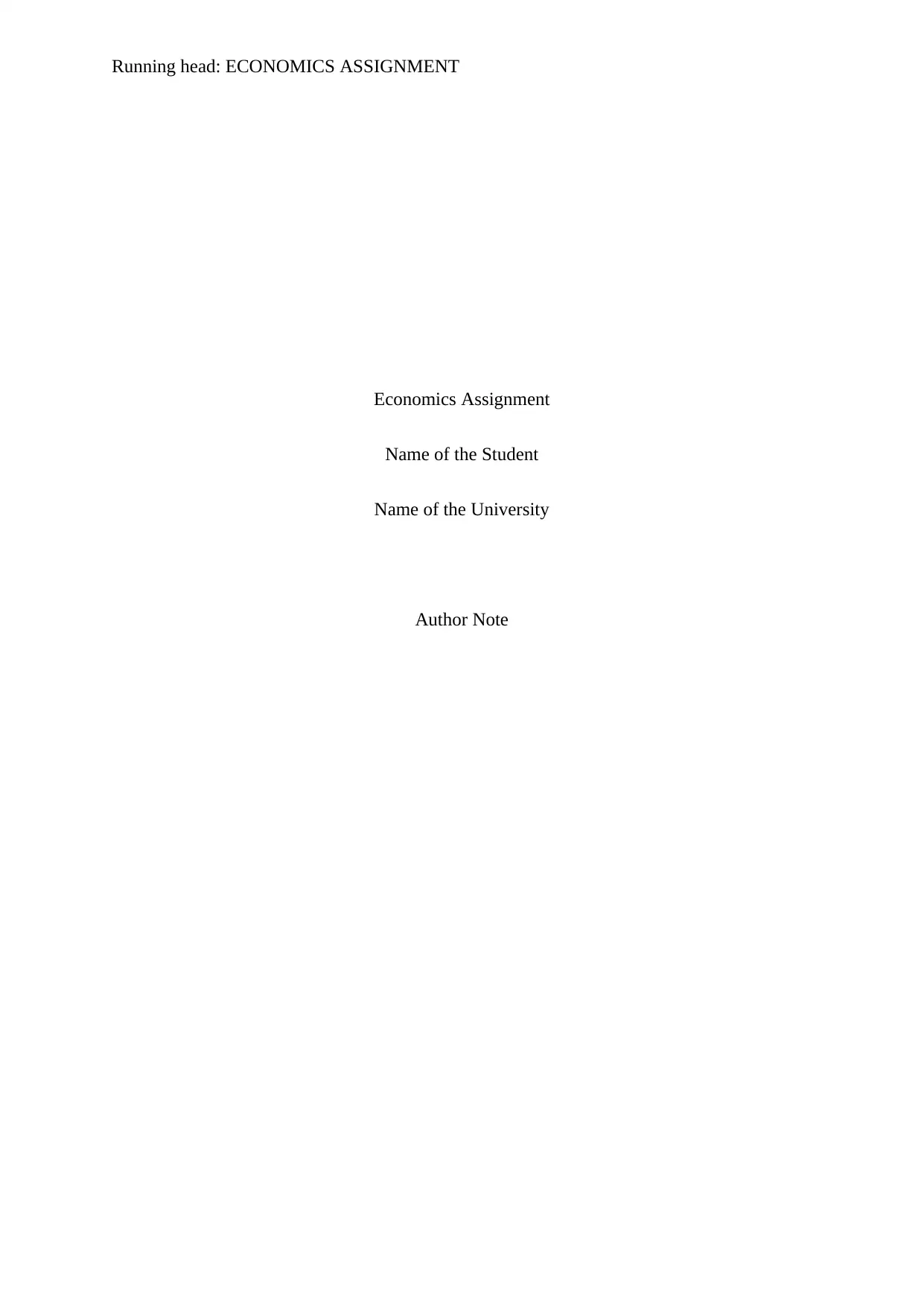
Running head: ECONOMICS ASSIGNMENT
Economics Assignment
Name of the Student
Name of the University
Author Note
Economics Assignment
Name of the Student
Name of the University
Author Note
Secure Best Marks with AI Grader
Need help grading? Try our AI Grader for instant feedback on your assignments.
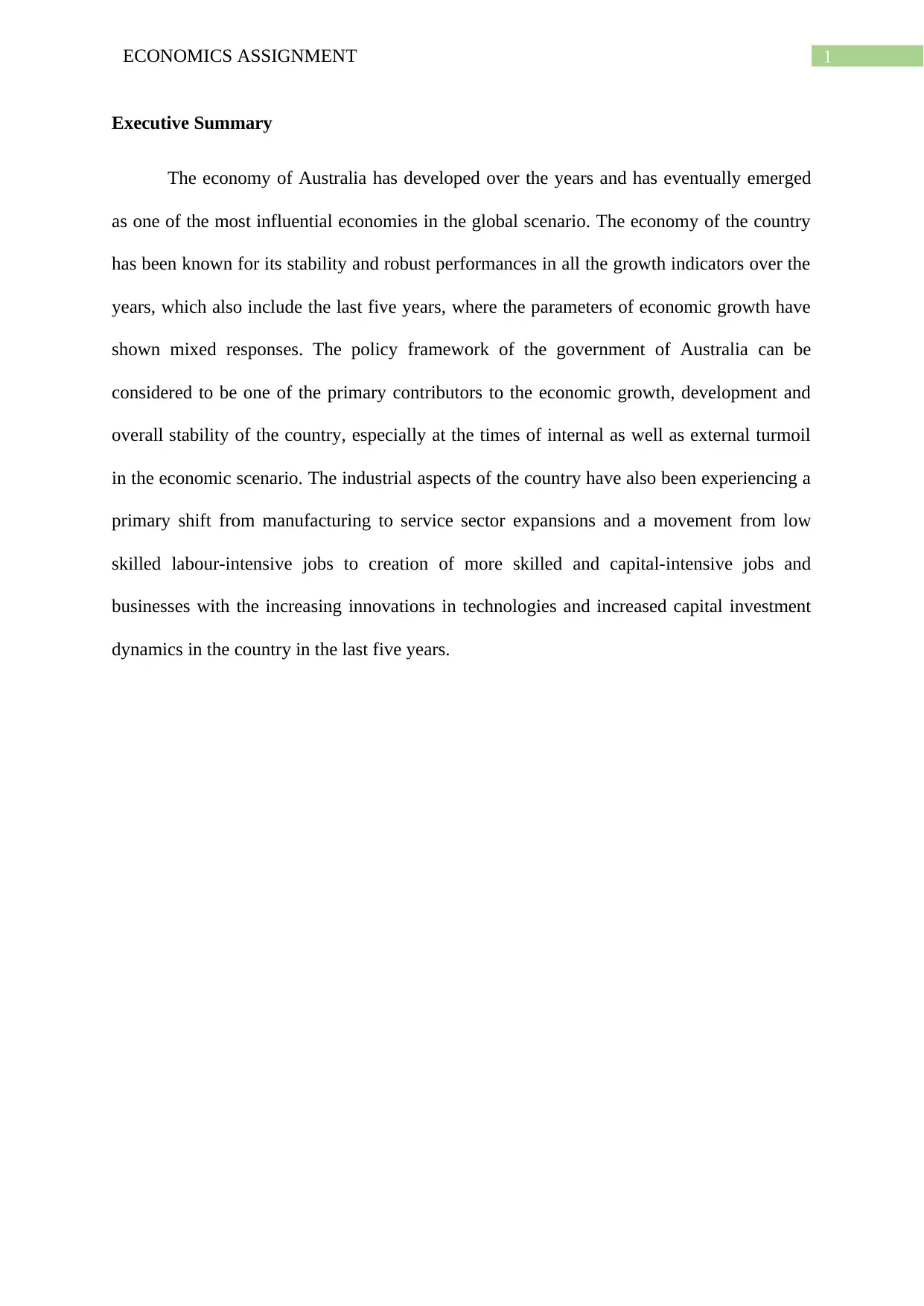
1ECONOMICS ASSIGNMENT
Executive Summary
The economy of Australia has developed over the years and has eventually emerged
as one of the most influential economies in the global scenario. The economy of the country
has been known for its stability and robust performances in all the growth indicators over the
years, which also include the last five years, where the parameters of economic growth have
shown mixed responses. The policy framework of the government of Australia can be
considered to be one of the primary contributors to the economic growth, development and
overall stability of the country, especially at the times of internal as well as external turmoil
in the economic scenario. The industrial aspects of the country have also been experiencing a
primary shift from manufacturing to service sector expansions and a movement from low
skilled labour-intensive jobs to creation of more skilled and capital-intensive jobs and
businesses with the increasing innovations in technologies and increased capital investment
dynamics in the country in the last five years.
Executive Summary
The economy of Australia has developed over the years and has eventually emerged
as one of the most influential economies in the global scenario. The economy of the country
has been known for its stability and robust performances in all the growth indicators over the
years, which also include the last five years, where the parameters of economic growth have
shown mixed responses. The policy framework of the government of Australia can be
considered to be one of the primary contributors to the economic growth, development and
overall stability of the country, especially at the times of internal as well as external turmoil
in the economic scenario. The industrial aspects of the country have also been experiencing a
primary shift from manufacturing to service sector expansions and a movement from low
skilled labour-intensive jobs to creation of more skilled and capital-intensive jobs and
businesses with the increasing innovations in technologies and increased capital investment
dynamics in the country in the last five years.
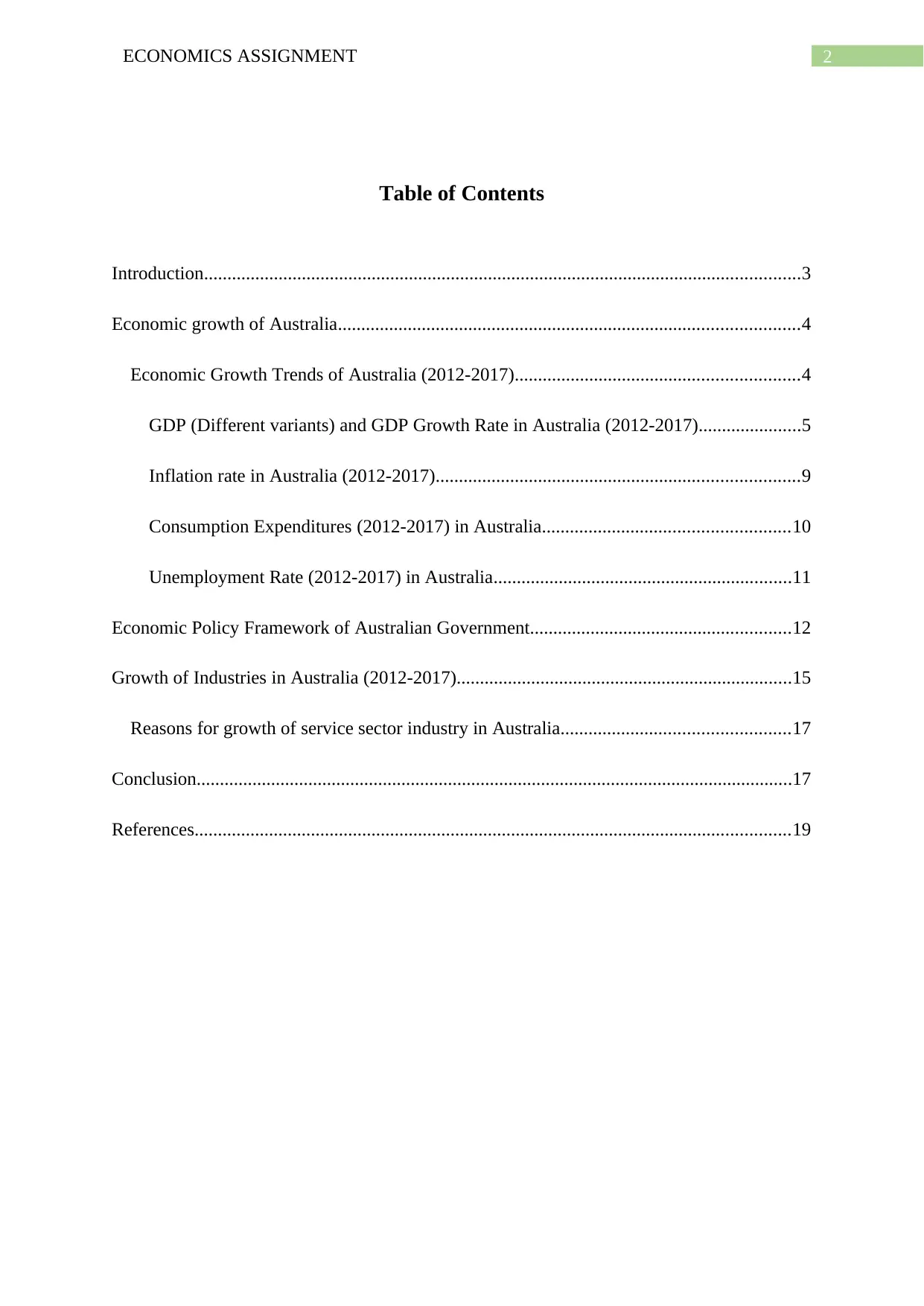
2ECONOMICS ASSIGNMENT
Table of Contents
Introduction................................................................................................................................3
Economic growth of Australia...................................................................................................4
Economic Growth Trends of Australia (2012-2017).............................................................4
GDP (Different variants) and GDP Growth Rate in Australia (2012-2017)......................5
Inflation rate in Australia (2012-2017)..............................................................................9
Consumption Expenditures (2012-2017) in Australia.....................................................10
Unemployment Rate (2012-2017) in Australia................................................................11
Economic Policy Framework of Australian Government........................................................12
Growth of Industries in Australia (2012-2017)........................................................................15
Reasons for growth of service sector industry in Australia.................................................17
Conclusion................................................................................................................................17
References................................................................................................................................19
Table of Contents
Introduction................................................................................................................................3
Economic growth of Australia...................................................................................................4
Economic Growth Trends of Australia (2012-2017).............................................................4
GDP (Different variants) and GDP Growth Rate in Australia (2012-2017)......................5
Inflation rate in Australia (2012-2017)..............................................................................9
Consumption Expenditures (2012-2017) in Australia.....................................................10
Unemployment Rate (2012-2017) in Australia................................................................11
Economic Policy Framework of Australian Government........................................................12
Growth of Industries in Australia (2012-2017)........................................................................15
Reasons for growth of service sector industry in Australia.................................................17
Conclusion................................................................................................................................17
References................................................................................................................................19

3ECONOMICS ASSIGNMENT
Introduction
The global economy has developed considerably over the years, experiencing
immense dynamics and fluctuations (both negative as well as positive) in its framework,
which in turn has led to the creation of the current shape of the global economy. However,
there has been always the existence of several significant economies in the global scenario,
which have, over the years developed significantly, thereby emerging as the dominant players
in the global economic scenario, with huge influences and decision-making power in the
aspects of the global economic dynamics (Uribe and Schmitt-Grohé 2017).
One of such globally dominating and influencing economies, which have developed
significantly over the years is that of the economy of Australia. Australia enjoys the position
of one of the leading developed countries across the globe, with a highly developed,
dominant and the largest mixed economy in the international framework. Australia also ranks
as the fourth largest economy in the world in terms of Nominal GDP, with wealth of nearly
8.9 trillion AUD (2016) (Downes, Hanslow and Tulip 2014). The country also ranks second
globally, in terms of the amount of wealth of the adult population, ranking just after
Switzerland. The economy of the country also stands out for its incredible stability, as well as
for its economic prosperity, which can be attributed to the growth of industrial and
commercial sectors of the country over the years.
However, in the contemporary period, the economy of Australia has been subjected to
considerable fluctuations in its growth parameters, both positive as well as negative, much of
which can be attributed to the dynamics in the industrial and commercial sectors and the
several booms as well as stagnation occurring in the business cycle in the contemporary
period (Dyster and Meredith 2012). Keeping this into consideration, the concerned report
tries to analyse the economic growth of Australia over the last five years (2012-2017),
Introduction
The global economy has developed considerably over the years, experiencing
immense dynamics and fluctuations (both negative as well as positive) in its framework,
which in turn has led to the creation of the current shape of the global economy. However,
there has been always the existence of several significant economies in the global scenario,
which have, over the years developed significantly, thereby emerging as the dominant players
in the global economic scenario, with huge influences and decision-making power in the
aspects of the global economic dynamics (Uribe and Schmitt-Grohé 2017).
One of such globally dominating and influencing economies, which have developed
significantly over the years is that of the economy of Australia. Australia enjoys the position
of one of the leading developed countries across the globe, with a highly developed,
dominant and the largest mixed economy in the international framework. Australia also ranks
as the fourth largest economy in the world in terms of Nominal GDP, with wealth of nearly
8.9 trillion AUD (2016) (Downes, Hanslow and Tulip 2014). The country also ranks second
globally, in terms of the amount of wealth of the adult population, ranking just after
Switzerland. The economy of the country also stands out for its incredible stability, as well as
for its economic prosperity, which can be attributed to the growth of industrial and
commercial sectors of the country over the years.
However, in the contemporary period, the economy of Australia has been subjected to
considerable fluctuations in its growth parameters, both positive as well as negative, much of
which can be attributed to the dynamics in the industrial and commercial sectors and the
several booms as well as stagnation occurring in the business cycle in the contemporary
period (Dyster and Meredith 2012). Keeping this into consideration, the concerned report
tries to analyse the economic growth of Australia over the last five years (2012-2017),
Secure Best Marks with AI Grader
Need help grading? Try our AI Grader for instant feedback on your assignments.
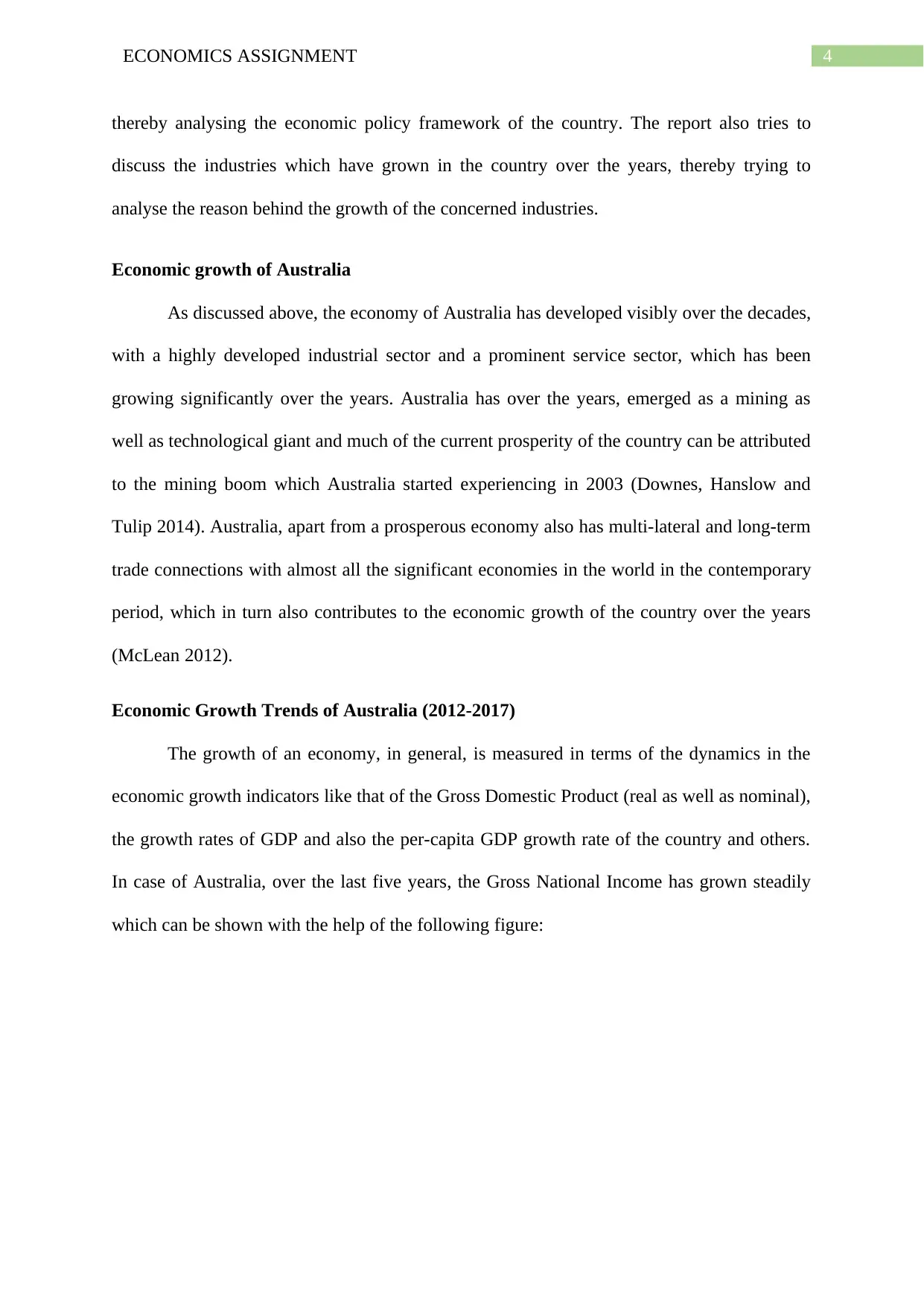
4ECONOMICS ASSIGNMENT
thereby analysing the economic policy framework of the country. The report also tries to
discuss the industries which have grown in the country over the years, thereby trying to
analyse the reason behind the growth of the concerned industries.
Economic growth of Australia
As discussed above, the economy of Australia has developed visibly over the decades,
with a highly developed industrial sector and a prominent service sector, which has been
growing significantly over the years. Australia has over the years, emerged as a mining as
well as technological giant and much of the current prosperity of the country can be attributed
to the mining boom which Australia started experiencing in 2003 (Downes, Hanslow and
Tulip 2014). Australia, apart from a prosperous economy also has multi-lateral and long-term
trade connections with almost all the significant economies in the world in the contemporary
period, which in turn also contributes to the economic growth of the country over the years
(McLean 2012).
Economic Growth Trends of Australia (2012-2017)
The growth of an economy, in general, is measured in terms of the dynamics in the
economic growth indicators like that of the Gross Domestic Product (real as well as nominal),
the growth rates of GDP and also the per-capita GDP growth rate of the country and others.
In case of Australia, over the last five years, the Gross National Income has grown steadily
which can be shown with the help of the following figure:
thereby analysing the economic policy framework of the country. The report also tries to
discuss the industries which have grown in the country over the years, thereby trying to
analyse the reason behind the growth of the concerned industries.
Economic growth of Australia
As discussed above, the economy of Australia has developed visibly over the decades,
with a highly developed industrial sector and a prominent service sector, which has been
growing significantly over the years. Australia has over the years, emerged as a mining as
well as technological giant and much of the current prosperity of the country can be attributed
to the mining boom which Australia started experiencing in 2003 (Downes, Hanslow and
Tulip 2014). Australia, apart from a prosperous economy also has multi-lateral and long-term
trade connections with almost all the significant economies in the world in the contemporary
period, which in turn also contributes to the economic growth of the country over the years
(McLean 2012).
Economic Growth Trends of Australia (2012-2017)
The growth of an economy, in general, is measured in terms of the dynamics in the
economic growth indicators like that of the Gross Domestic Product (real as well as nominal),
the growth rates of GDP and also the per-capita GDP growth rate of the country and others.
In case of Australia, over the last five years, the Gross National Income has grown steadily
which can be shown with the help of the following figure:
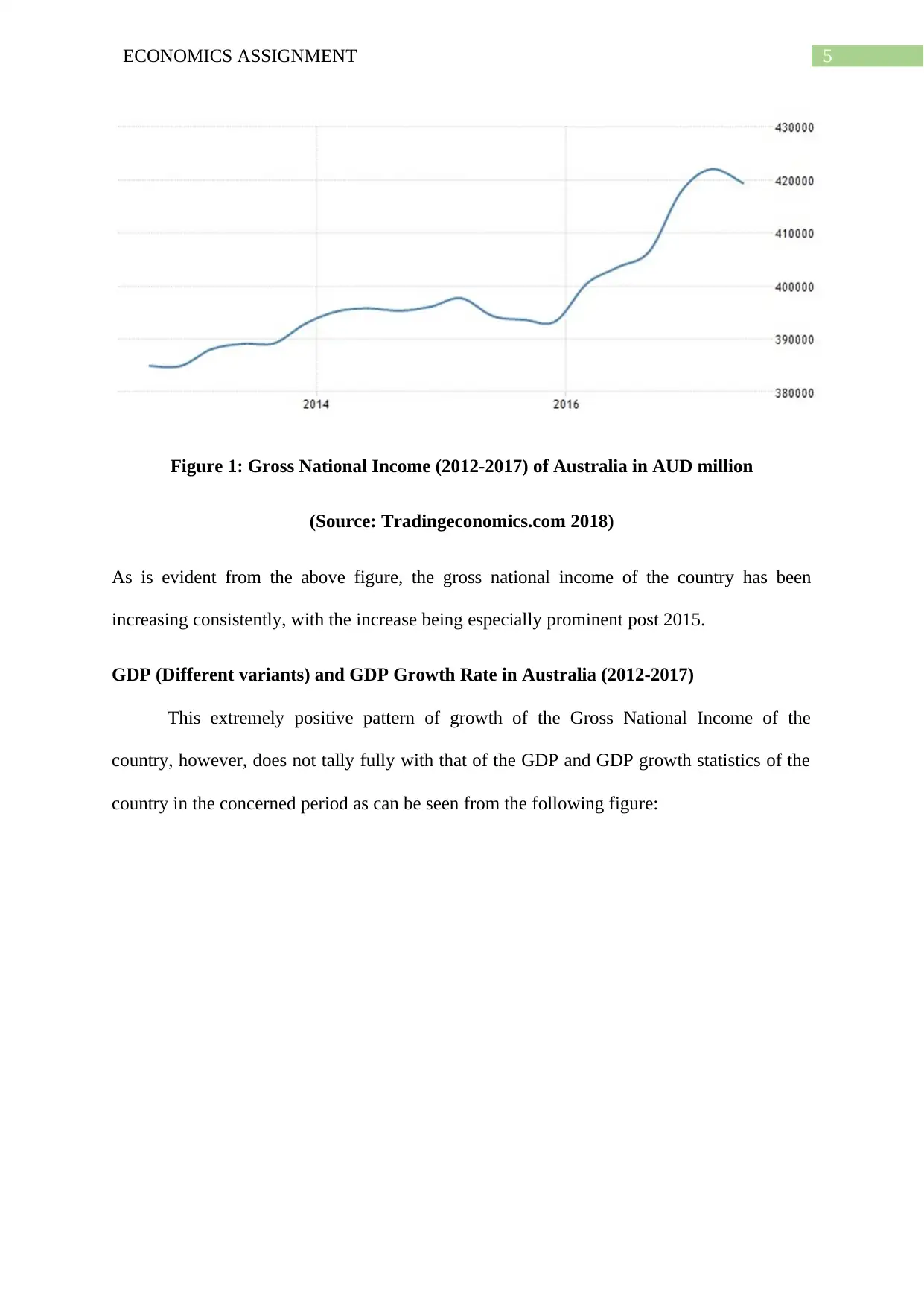
5ECONOMICS ASSIGNMENT
Figure 1: Gross National Income (2012-2017) of Australia in AUD million
(Source: Tradingeconomics.com 2018)
As is evident from the above figure, the gross national income of the country has been
increasing consistently, with the increase being especially prominent post 2015.
GDP (Different variants) and GDP Growth Rate in Australia (2012-2017)
This extremely positive pattern of growth of the Gross National Income of the
country, however, does not tally fully with that of the GDP and GDP growth statistics of the
country in the concerned period as can be seen from the following figure:
Figure 1: Gross National Income (2012-2017) of Australia in AUD million
(Source: Tradingeconomics.com 2018)
As is evident from the above figure, the gross national income of the country has been
increasing consistently, with the increase being especially prominent post 2015.
GDP (Different variants) and GDP Growth Rate in Australia (2012-2017)
This extremely positive pattern of growth of the Gross National Income of the
country, however, does not tally fully with that of the GDP and GDP growth statistics of the
country in the concerned period as can be seen from the following figure:
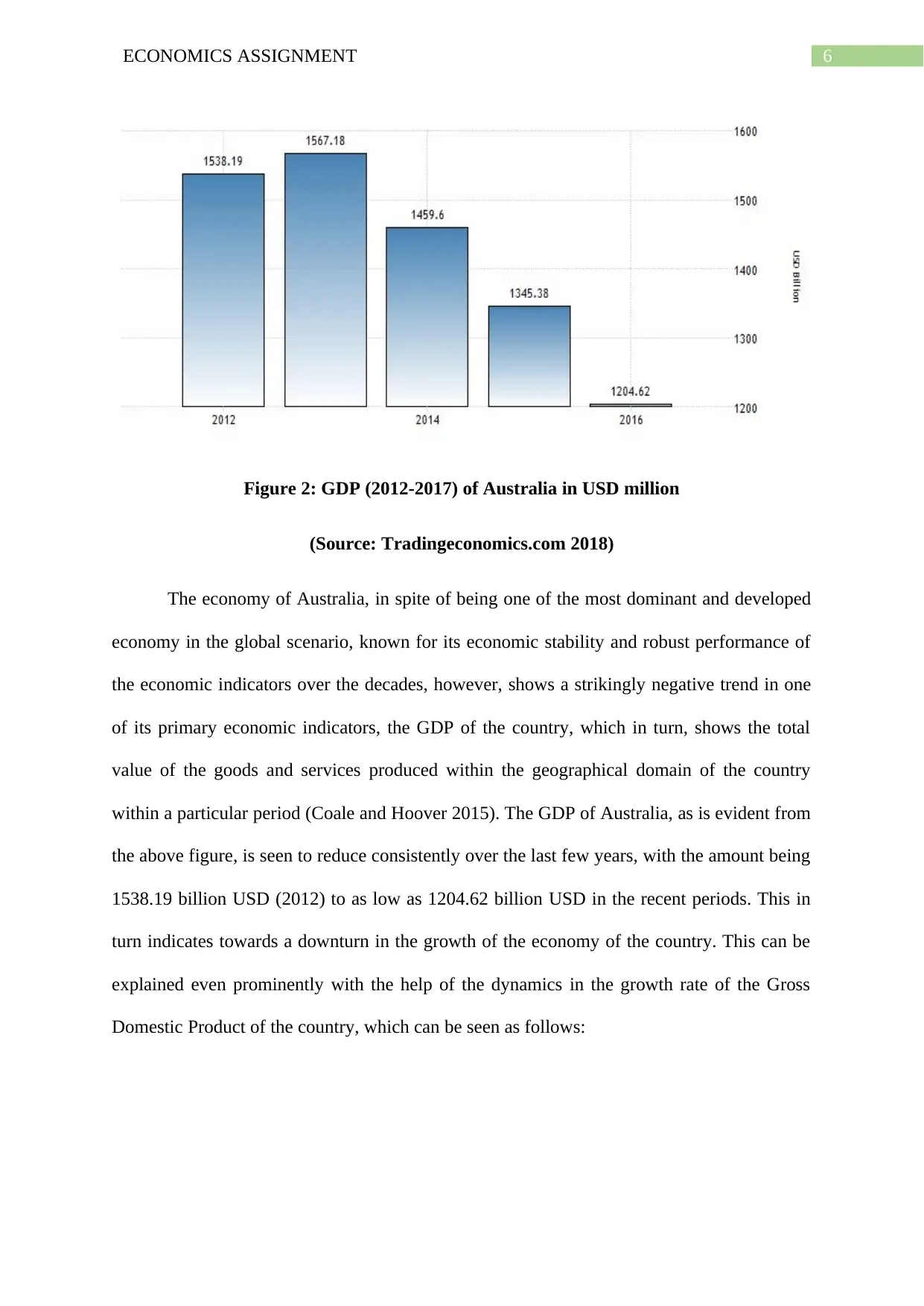
6ECONOMICS ASSIGNMENT
Figure 2: GDP (2012-2017) of Australia in USD million
(Source: Tradingeconomics.com 2018)
The economy of Australia, in spite of being one of the most dominant and developed
economy in the global scenario, known for its economic stability and robust performance of
the economic indicators over the decades, however, shows a strikingly negative trend in one
of its primary economic indicators, the GDP of the country, which in turn, shows the total
value of the goods and services produced within the geographical domain of the country
within a particular period (Coale and Hoover 2015). The GDP of Australia, as is evident from
the above figure, is seen to reduce consistently over the last few years, with the amount being
1538.19 billion USD (2012) to as low as 1204.62 billion USD in the recent periods. This in
turn indicates towards a downturn in the growth of the economy of the country. This can be
explained even prominently with the help of the dynamics in the growth rate of the Gross
Domestic Product of the country, which can be seen as follows:
Figure 2: GDP (2012-2017) of Australia in USD million
(Source: Tradingeconomics.com 2018)
The economy of Australia, in spite of being one of the most dominant and developed
economy in the global scenario, known for its economic stability and robust performance of
the economic indicators over the decades, however, shows a strikingly negative trend in one
of its primary economic indicators, the GDP of the country, which in turn, shows the total
value of the goods and services produced within the geographical domain of the country
within a particular period (Coale and Hoover 2015). The GDP of Australia, as is evident from
the above figure, is seen to reduce consistently over the last few years, with the amount being
1538.19 billion USD (2012) to as low as 1204.62 billion USD in the recent periods. This in
turn indicates towards a downturn in the growth of the economy of the country. This can be
explained even prominently with the help of the dynamics in the growth rate of the Gross
Domestic Product of the country, which can be seen as follows:
Paraphrase This Document
Need a fresh take? Get an instant paraphrase of this document with our AI Paraphraser

7ECONOMICS ASSIGNMENT
Figure 3: Growth rate of GDP (2012-2017) in Australia
(Source: Tradingeconomics.com 2018)
As can be seen from the above figure, the growth rate of GDP of the country has
experienced considerable fluctuations over the last five years, with the fluctuations being
much more evident post 2016, as can be seen from the huge dip in the growth rate in end
quarter of 2016, which was however overcame by the economy quickly in the succeeding
periods (Ianchovichina and Walmsley 2012).
Thus, from the above statistical evidences, it can be asserted the economy of the
country, has not bee experiencing a positive trend in its GDP and GDP growth dynamics over
the last few years. However, the growth of GDP alone cannot fully reflect the overall
economic growth and economic well being of the population of a country at a point of time
(Downes, Hanslow and Tulip 2014). The growth and development of the economy of a
country also depends on the distribution of the GDP across the population of the country,
which is to some extent, measured by the Per-Capita GDP of the country, which in turn
indicates the average income of the members of the population of the country. In case of
Australia, this can be seen from the following figure:
Figure 3: Growth rate of GDP (2012-2017) in Australia
(Source: Tradingeconomics.com 2018)
As can be seen from the above figure, the growth rate of GDP of the country has
experienced considerable fluctuations over the last five years, with the fluctuations being
much more evident post 2016, as can be seen from the huge dip in the growth rate in end
quarter of 2016, which was however overcame by the economy quickly in the succeeding
periods (Ianchovichina and Walmsley 2012).
Thus, from the above statistical evidences, it can be asserted the economy of the
country, has not bee experiencing a positive trend in its GDP and GDP growth dynamics over
the last few years. However, the growth of GDP alone cannot fully reflect the overall
economic growth and economic well being of the population of a country at a point of time
(Downes, Hanslow and Tulip 2014). The growth and development of the economy of a
country also depends on the distribution of the GDP across the population of the country,
which is to some extent, measured by the Per-Capita GDP of the country, which in turn
indicates the average income of the members of the population of the country. In case of
Australia, this can be seen from the following figure:
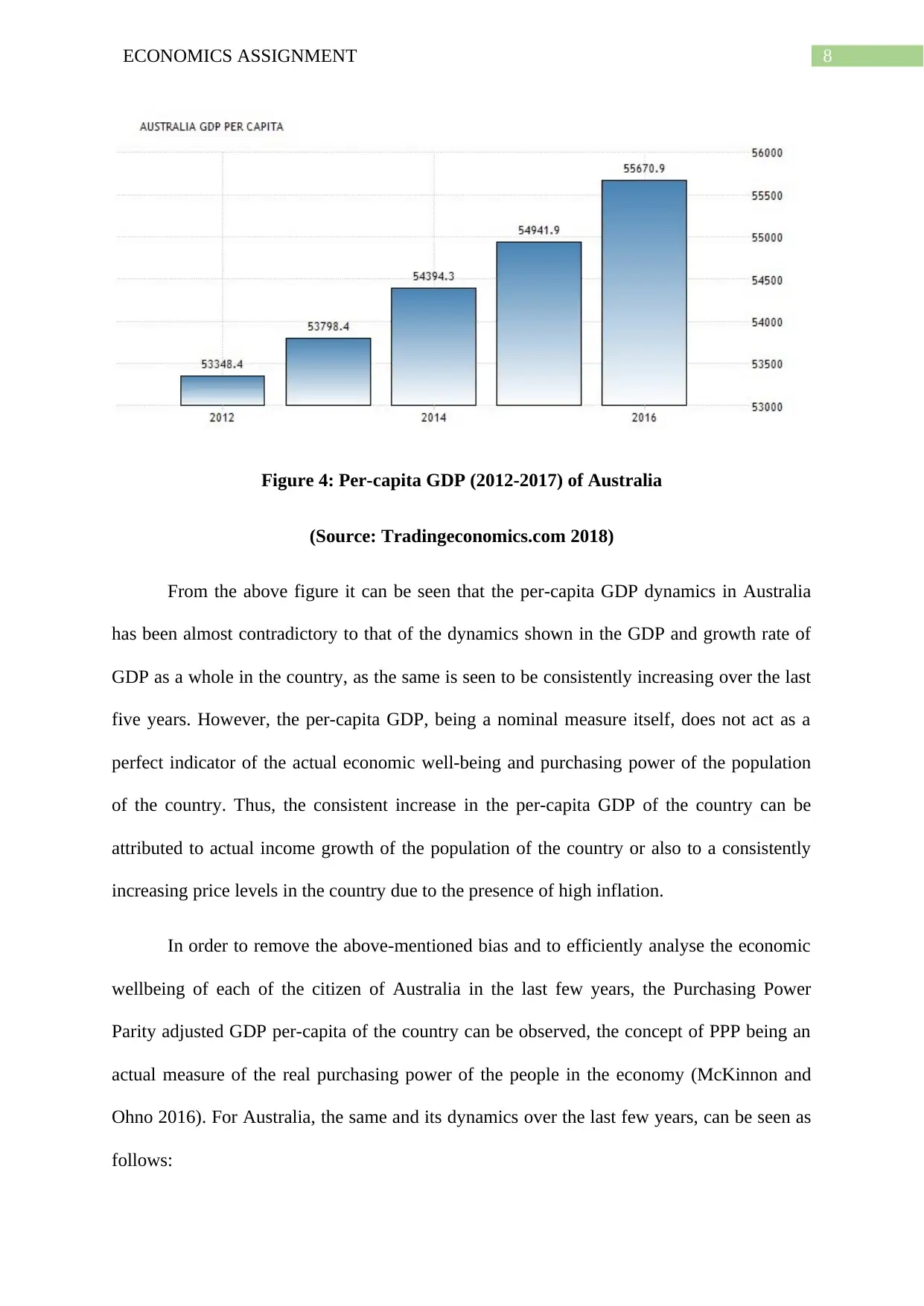
8ECONOMICS ASSIGNMENT
Figure 4: Per-capita GDP (2012-2017) of Australia
(Source: Tradingeconomics.com 2018)
From the above figure it can be seen that the per-capita GDP dynamics in Australia
has been almost contradictory to that of the dynamics shown in the GDP and growth rate of
GDP as a whole in the country, as the same is seen to be consistently increasing over the last
five years. However, the per-capita GDP, being a nominal measure itself, does not act as a
perfect indicator of the actual economic well-being and purchasing power of the population
of the country. Thus, the consistent increase in the per-capita GDP of the country can be
attributed to actual income growth of the population of the country or also to a consistently
increasing price levels in the country due to the presence of high inflation.
In order to remove the above-mentioned bias and to efficiently analyse the economic
wellbeing of each of the citizen of Australia in the last few years, the Purchasing Power
Parity adjusted GDP per-capita of the country can be observed, the concept of PPP being an
actual measure of the real purchasing power of the people in the economy (McKinnon and
Ohno 2016). For Australia, the same and its dynamics over the last few years, can be seen as
follows:
Figure 4: Per-capita GDP (2012-2017) of Australia
(Source: Tradingeconomics.com 2018)
From the above figure it can be seen that the per-capita GDP dynamics in Australia
has been almost contradictory to that of the dynamics shown in the GDP and growth rate of
GDP as a whole in the country, as the same is seen to be consistently increasing over the last
five years. However, the per-capita GDP, being a nominal measure itself, does not act as a
perfect indicator of the actual economic well-being and purchasing power of the population
of the country. Thus, the consistent increase in the per-capita GDP of the country can be
attributed to actual income growth of the population of the country or also to a consistently
increasing price levels in the country due to the presence of high inflation.
In order to remove the above-mentioned bias and to efficiently analyse the economic
wellbeing of each of the citizen of Australia in the last few years, the Purchasing Power
Parity adjusted GDP per-capita of the country can be observed, the concept of PPP being an
actual measure of the real purchasing power of the people in the economy (McKinnon and
Ohno 2016). For Australia, the same and its dynamics over the last few years, can be seen as
follows:
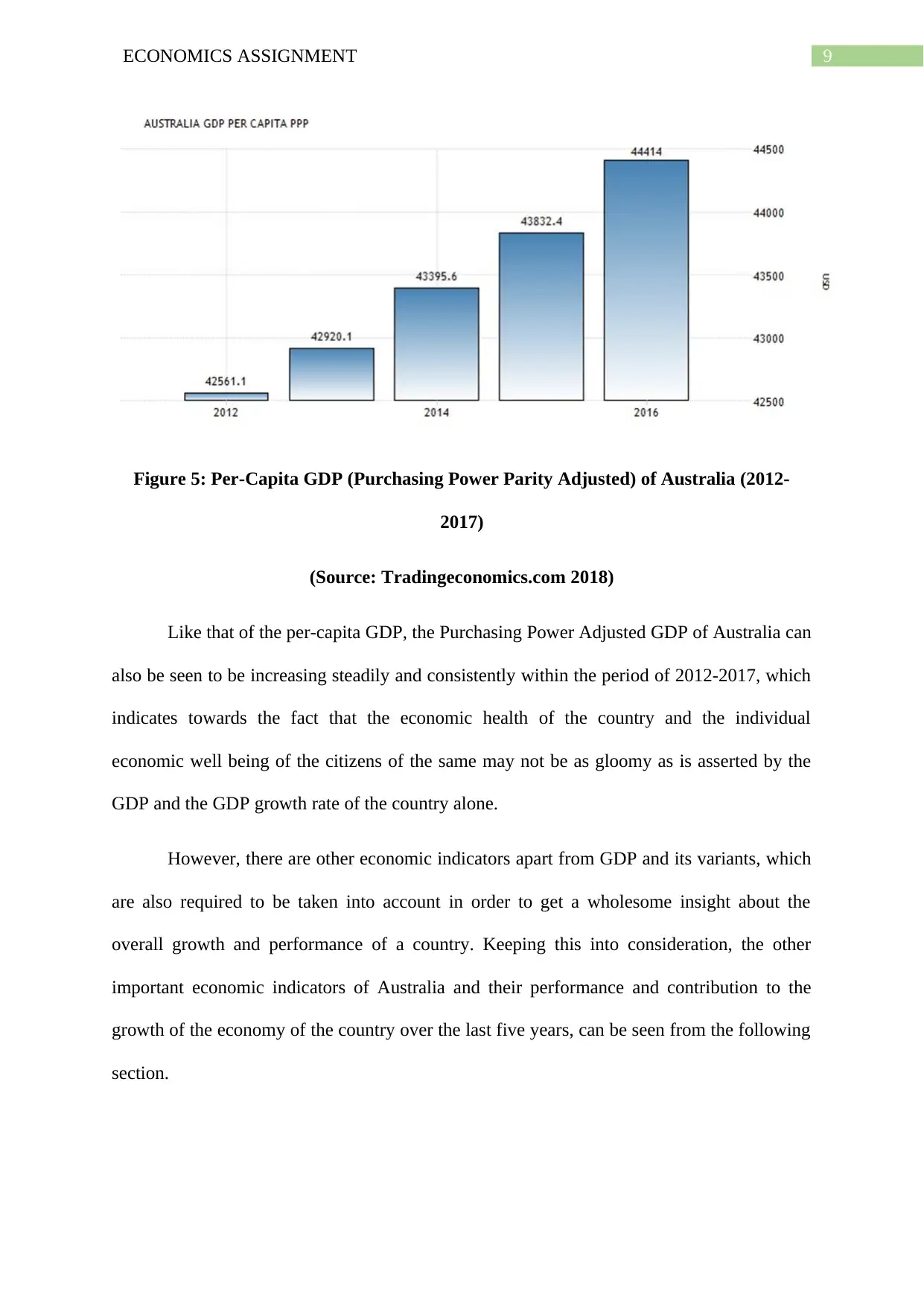
9ECONOMICS ASSIGNMENT
Figure 5: Per-Capita GDP (Purchasing Power Parity Adjusted) of Australia (2012-
2017)
(Source: Tradingeconomics.com 2018)
Like that of the per-capita GDP, the Purchasing Power Adjusted GDP of Australia can
also be seen to be increasing steadily and consistently within the period of 2012-2017, which
indicates towards the fact that the economic health of the country and the individual
economic well being of the citizens of the same may not be as gloomy as is asserted by the
GDP and the GDP growth rate of the country alone.
However, there are other economic indicators apart from GDP and its variants, which
are also required to be taken into account in order to get a wholesome insight about the
overall growth and performance of a country. Keeping this into consideration, the other
important economic indicators of Australia and their performance and contribution to the
growth of the economy of the country over the last five years, can be seen from the following
section.
Figure 5: Per-Capita GDP (Purchasing Power Parity Adjusted) of Australia (2012-
2017)
(Source: Tradingeconomics.com 2018)
Like that of the per-capita GDP, the Purchasing Power Adjusted GDP of Australia can
also be seen to be increasing steadily and consistently within the period of 2012-2017, which
indicates towards the fact that the economic health of the country and the individual
economic well being of the citizens of the same may not be as gloomy as is asserted by the
GDP and the GDP growth rate of the country alone.
However, there are other economic indicators apart from GDP and its variants, which
are also required to be taken into account in order to get a wholesome insight about the
overall growth and performance of a country. Keeping this into consideration, the other
important economic indicators of Australia and their performance and contribution to the
growth of the economy of the country over the last five years, can be seen from the following
section.
Secure Best Marks with AI Grader
Need help grading? Try our AI Grader for instant feedback on your assignments.
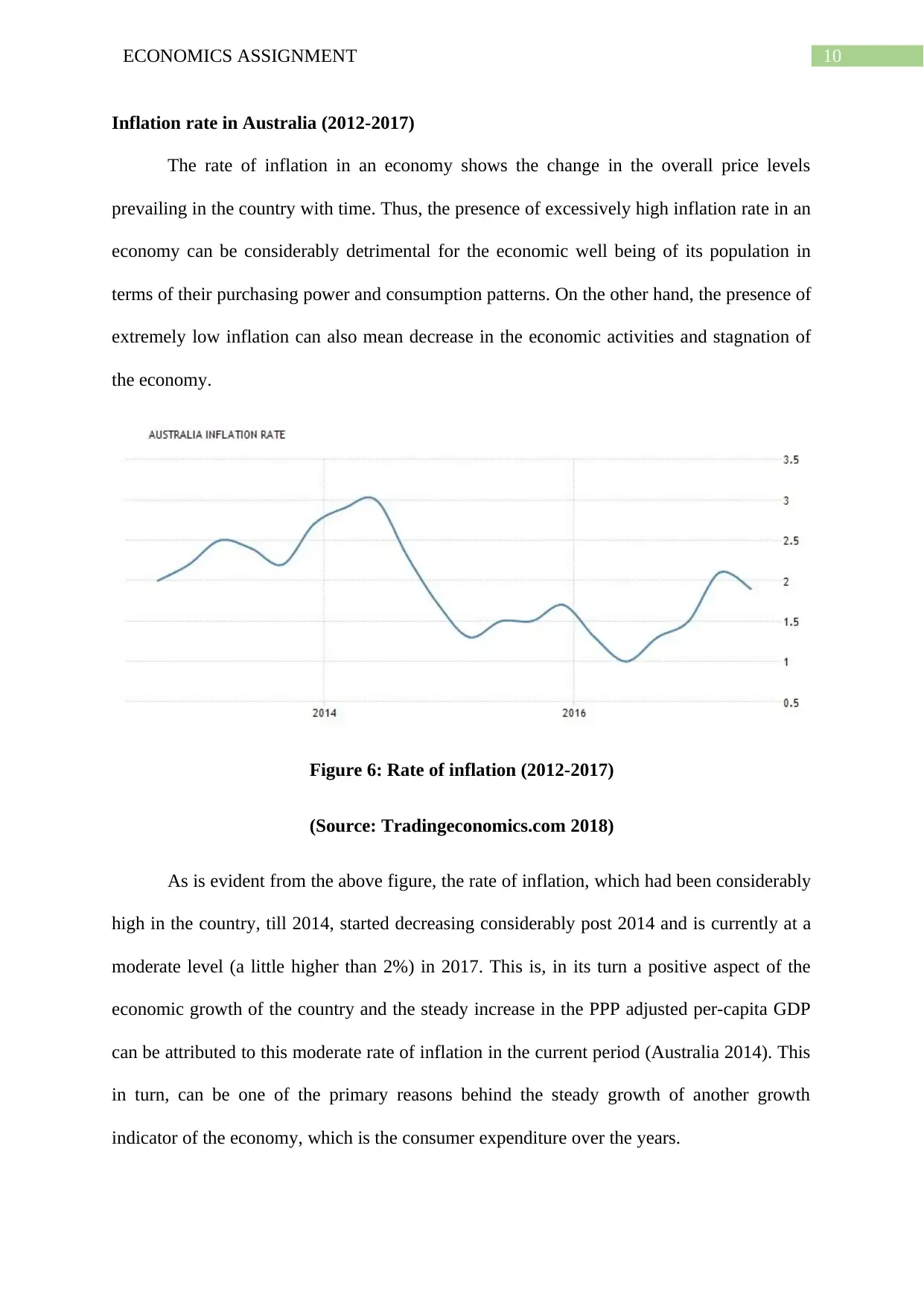
10ECONOMICS ASSIGNMENT
Inflation rate in Australia (2012-2017)
The rate of inflation in an economy shows the change in the overall price levels
prevailing in the country with time. Thus, the presence of excessively high inflation rate in an
economy can be considerably detrimental for the economic well being of its population in
terms of their purchasing power and consumption patterns. On the other hand, the presence of
extremely low inflation can also mean decrease in the economic activities and stagnation of
the economy.
Figure 6: Rate of inflation (2012-2017)
(Source: Tradingeconomics.com 2018)
As is evident from the above figure, the rate of inflation, which had been considerably
high in the country, till 2014, started decreasing considerably post 2014 and is currently at a
moderate level (a little higher than 2%) in 2017. This is, in its turn a positive aspect of the
economic growth of the country and the steady increase in the PPP adjusted per-capita GDP
can be attributed to this moderate rate of inflation in the current period (Australia 2014). This
in turn, can be one of the primary reasons behind the steady growth of another growth
indicator of the economy, which is the consumer expenditure over the years.
Inflation rate in Australia (2012-2017)
The rate of inflation in an economy shows the change in the overall price levels
prevailing in the country with time. Thus, the presence of excessively high inflation rate in an
economy can be considerably detrimental for the economic well being of its population in
terms of their purchasing power and consumption patterns. On the other hand, the presence of
extremely low inflation can also mean decrease in the economic activities and stagnation of
the economy.
Figure 6: Rate of inflation (2012-2017)
(Source: Tradingeconomics.com 2018)
As is evident from the above figure, the rate of inflation, which had been considerably
high in the country, till 2014, started decreasing considerably post 2014 and is currently at a
moderate level (a little higher than 2%) in 2017. This is, in its turn a positive aspect of the
economic growth of the country and the steady increase in the PPP adjusted per-capita GDP
can be attributed to this moderate rate of inflation in the current period (Australia 2014). This
in turn, can be one of the primary reasons behind the steady growth of another growth
indicator of the economy, which is the consumer expenditure over the years.

11ECONOMICS ASSIGNMENT
Consumption Expenditures (2012-2017) in Australia
In general, the amount of consumption expenditure in the country and its dynamics
shows the economic well being of the residents of the country which in turn also reflects
towards the dynamics in the overall productivity in the economy of the country.
Figure 7: Consumption expenditure (2012-2017) in Australia
(Source: Tradingeconomics.com 2018)
The steady increase in the consumption expenditure in Australia over the last five
years indicates towards the presence of considerable economic well-being of the overall
population of the country and also towards the increase in the industrial and commercial
prospects of the country due to the induced increase in the productivity of the country, due to
an increasing aggregate demand over the years (Australia 2014).
Unemployment Rate (2012-2017) in Australia
The economic growth of a country is also measure by the number of jobs present and
the scopes of creation of new jobs in the economy as higher job scopes indicates towards
more employment in the country, which in turn indicates towards higher economic
productivity of the country.
Consumption Expenditures (2012-2017) in Australia
In general, the amount of consumption expenditure in the country and its dynamics
shows the economic well being of the residents of the country which in turn also reflects
towards the dynamics in the overall productivity in the economy of the country.
Figure 7: Consumption expenditure (2012-2017) in Australia
(Source: Tradingeconomics.com 2018)
The steady increase in the consumption expenditure in Australia over the last five
years indicates towards the presence of considerable economic well-being of the overall
population of the country and also towards the increase in the industrial and commercial
prospects of the country due to the induced increase in the productivity of the country, due to
an increasing aggregate demand over the years (Australia 2014).
Unemployment Rate (2012-2017) in Australia
The economic growth of a country is also measure by the number of jobs present and
the scopes of creation of new jobs in the economy as higher job scopes indicates towards
more employment in the country, which in turn indicates towards higher economic
productivity of the country.
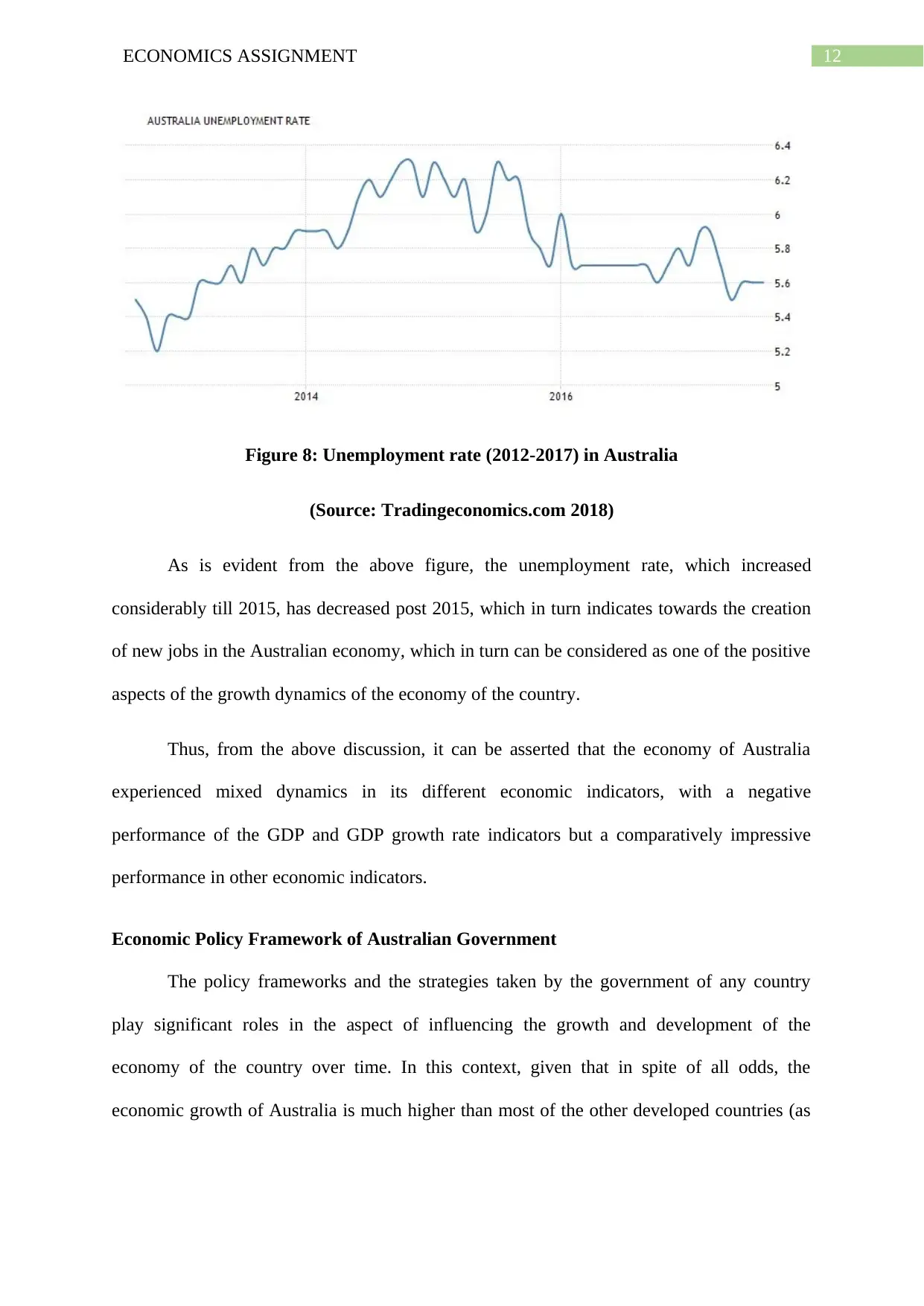
12ECONOMICS ASSIGNMENT
Figure 8: Unemployment rate (2012-2017) in Australia
(Source: Tradingeconomics.com 2018)
As is evident from the above figure, the unemployment rate, which increased
considerably till 2015, has decreased post 2015, which in turn indicates towards the creation
of new jobs in the Australian economy, which in turn can be considered as one of the positive
aspects of the growth dynamics of the economy of the country.
Thus, from the above discussion, it can be asserted that the economy of Australia
experienced mixed dynamics in its different economic indicators, with a negative
performance of the GDP and GDP growth rate indicators but a comparatively impressive
performance in other economic indicators.
Economic Policy Framework of Australian Government
The policy frameworks and the strategies taken by the government of any country
play significant roles in the aspect of influencing the growth and development of the
economy of the country over time. In this context, given that in spite of all odds, the
economic growth of Australia is much higher than most of the other developed countries (as
Figure 8: Unemployment rate (2012-2017) in Australia
(Source: Tradingeconomics.com 2018)
As is evident from the above figure, the unemployment rate, which increased
considerably till 2015, has decreased post 2015, which in turn indicates towards the creation
of new jobs in the Australian economy, which in turn can be considered as one of the positive
aspects of the growth dynamics of the economy of the country.
Thus, from the above discussion, it can be asserted that the economy of Australia
experienced mixed dynamics in its different economic indicators, with a negative
performance of the GDP and GDP growth rate indicators but a comparatively impressive
performance in other economic indicators.
Economic Policy Framework of Australian Government
The policy frameworks and the strategies taken by the government of any country
play significant roles in the aspect of influencing the growth and development of the
economy of the country over time. In this context, given that in spite of all odds, the
economic growth of Australia is much higher than most of the other developed countries (as
Paraphrase This Document
Need a fresh take? Get an instant paraphrase of this document with our AI Paraphraser
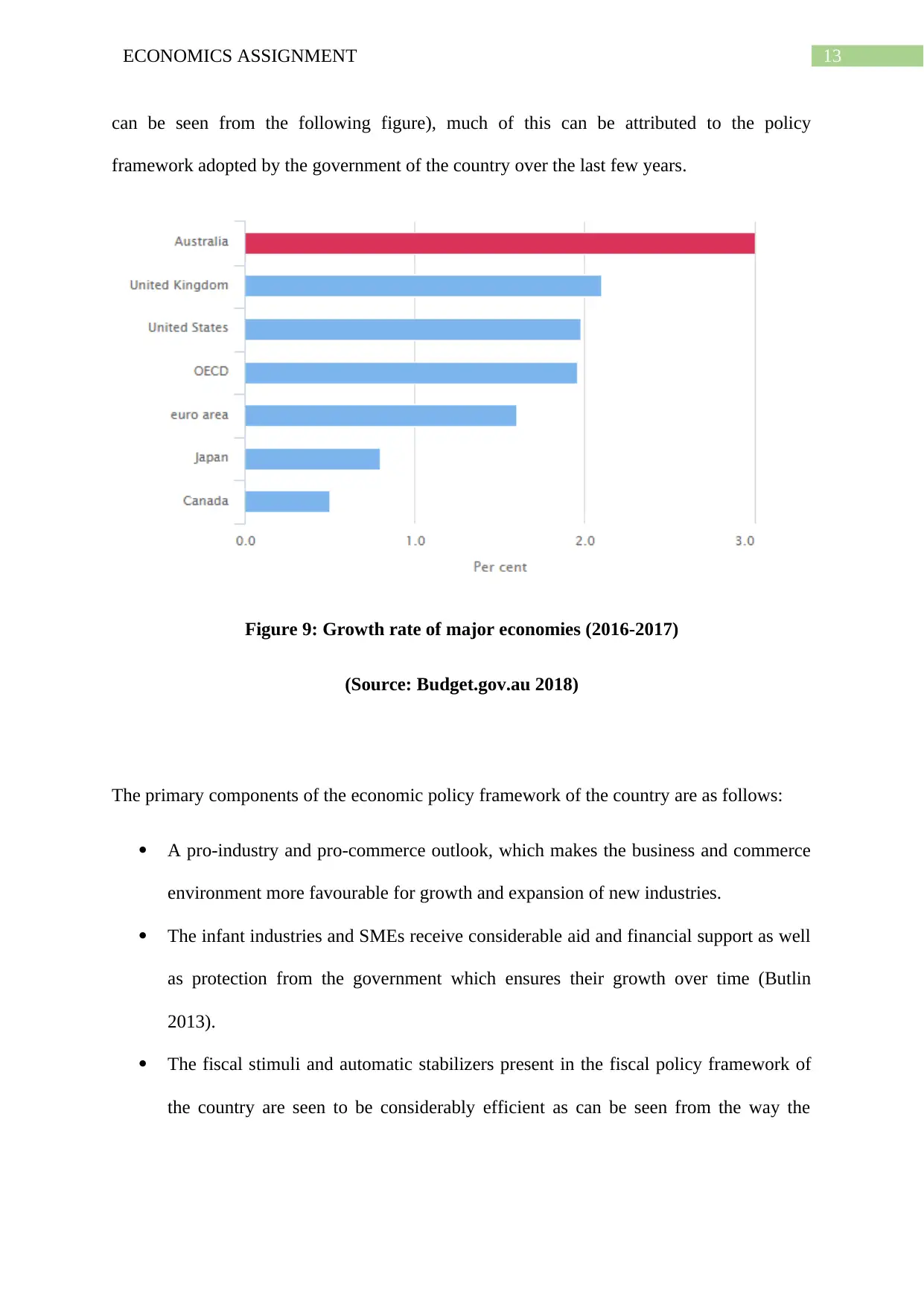
13ECONOMICS ASSIGNMENT
can be seen from the following figure), much of this can be attributed to the policy
framework adopted by the government of the country over the last few years.
Figure 9: Growth rate of major economies (2016-2017)
(Source: Budget.gov.au 2018)
The primary components of the economic policy framework of the country are as follows:
A pro-industry and pro-commerce outlook, which makes the business and commerce
environment more favourable for growth and expansion of new industries.
The infant industries and SMEs receive considerable aid and financial support as well
as protection from the government which ensures their growth over time (Butlin
2013).
The fiscal stimuli and automatic stabilizers present in the fiscal policy framework of
the country are seen to be considerably efficient as can be seen from the way the
can be seen from the following figure), much of this can be attributed to the policy
framework adopted by the government of the country over the last few years.
Figure 9: Growth rate of major economies (2016-2017)
(Source: Budget.gov.au 2018)
The primary components of the economic policy framework of the country are as follows:
A pro-industry and pro-commerce outlook, which makes the business and commerce
environment more favourable for growth and expansion of new industries.
The infant industries and SMEs receive considerable aid and financial support as well
as protection from the government which ensures their growth over time (Butlin
2013).
The fiscal stimuli and automatic stabilizers present in the fiscal policy framework of
the country are seen to be considerably efficient as can be seen from the way the
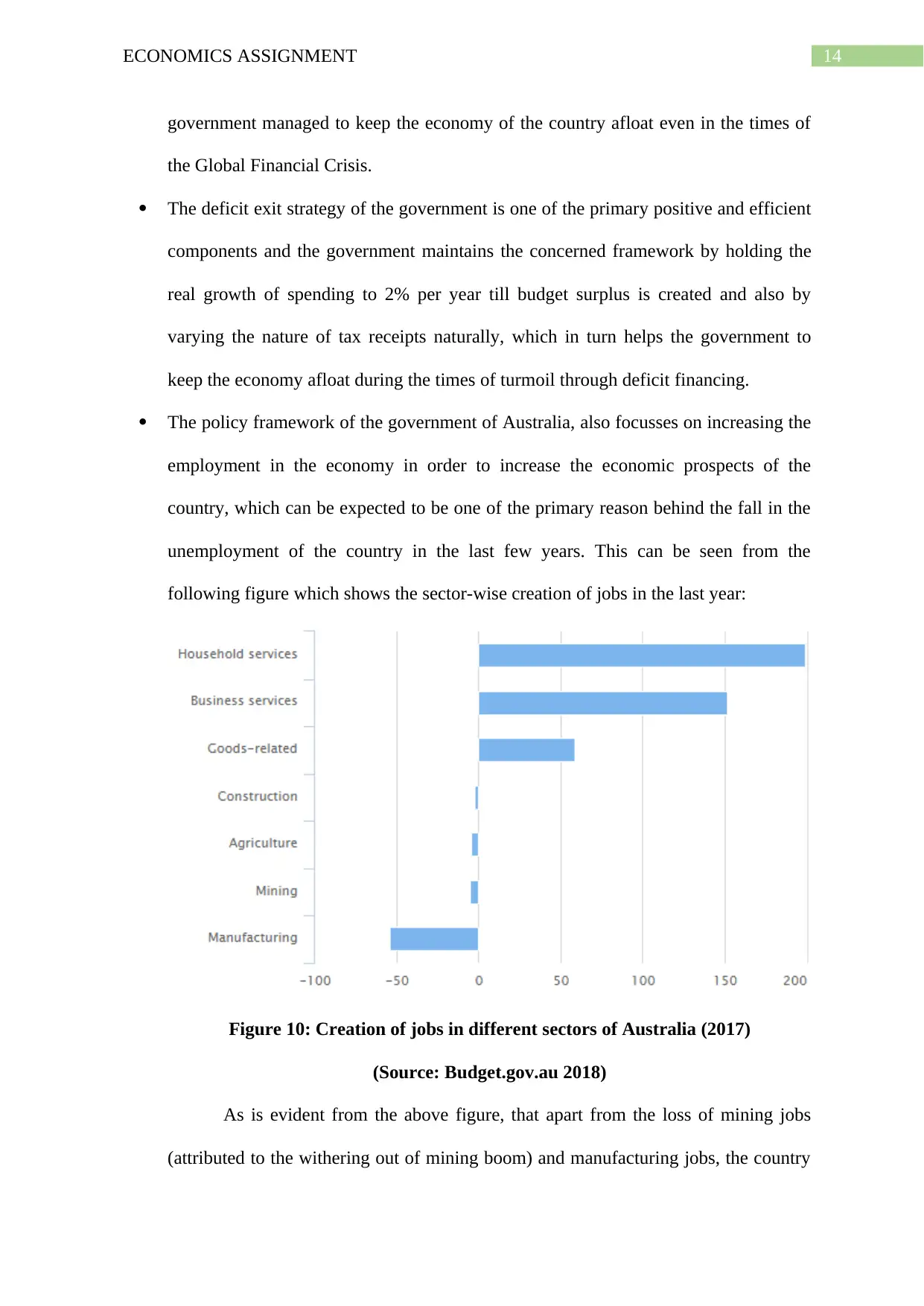
14ECONOMICS ASSIGNMENT
government managed to keep the economy of the country afloat even in the times of
the Global Financial Crisis.
The deficit exit strategy of the government is one of the primary positive and efficient
components and the government maintains the concerned framework by holding the
real growth of spending to 2% per year till budget surplus is created and also by
varying the nature of tax receipts naturally, which in turn helps the government to
keep the economy afloat during the times of turmoil through deficit financing.
The policy framework of the government of Australia, also focusses on increasing the
employment in the economy in order to increase the economic prospects of the
country, which can be expected to be one of the primary reason behind the fall in the
unemployment of the country in the last few years. This can be seen from the
following figure which shows the sector-wise creation of jobs in the last year:
Figure 10: Creation of jobs in different sectors of Australia (2017)
(Source: Budget.gov.au 2018)
As is evident from the above figure, that apart from the loss of mining jobs
(attributed to the withering out of mining boom) and manufacturing jobs, the country
government managed to keep the economy of the country afloat even in the times of
the Global Financial Crisis.
The deficit exit strategy of the government is one of the primary positive and efficient
components and the government maintains the concerned framework by holding the
real growth of spending to 2% per year till budget surplus is created and also by
varying the nature of tax receipts naturally, which in turn helps the government to
keep the economy afloat during the times of turmoil through deficit financing.
The policy framework of the government of Australia, also focusses on increasing the
employment in the economy in order to increase the economic prospects of the
country, which can be expected to be one of the primary reason behind the fall in the
unemployment of the country in the last few years. This can be seen from the
following figure which shows the sector-wise creation of jobs in the last year:
Figure 10: Creation of jobs in different sectors of Australia (2017)
(Source: Budget.gov.au 2018)
As is evident from the above figure, that apart from the loss of mining jobs
(attributed to the withering out of mining boom) and manufacturing jobs, the country
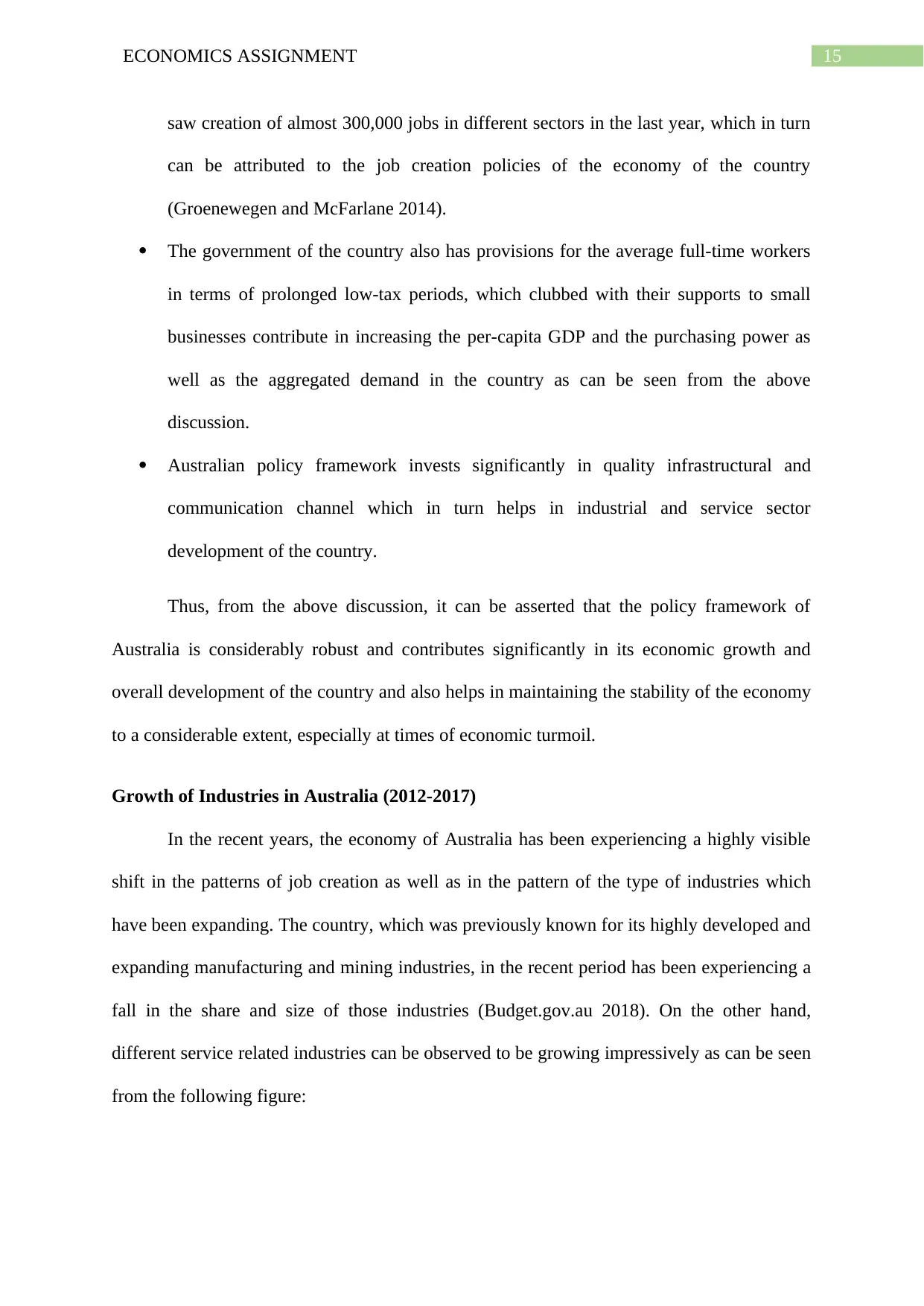
15ECONOMICS ASSIGNMENT
saw creation of almost 300,000 jobs in different sectors in the last year, which in turn
can be attributed to the job creation policies of the economy of the country
(Groenewegen and McFarlane 2014).
The government of the country also has provisions for the average full-time workers
in terms of prolonged low-tax periods, which clubbed with their supports to small
businesses contribute in increasing the per-capita GDP and the purchasing power as
well as the aggregated demand in the country as can be seen from the above
discussion.
Australian policy framework invests significantly in quality infrastructural and
communication channel which in turn helps in industrial and service sector
development of the country.
Thus, from the above discussion, it can be asserted that the policy framework of
Australia is considerably robust and contributes significantly in its economic growth and
overall development of the country and also helps in maintaining the stability of the economy
to a considerable extent, especially at times of economic turmoil.
Growth of Industries in Australia (2012-2017)
In the recent years, the economy of Australia has been experiencing a highly visible
shift in the patterns of job creation as well as in the pattern of the type of industries which
have been expanding. The country, which was previously known for its highly developed and
expanding manufacturing and mining industries, in the recent period has been experiencing a
fall in the share and size of those industries (Budget.gov.au 2018). On the other hand,
different service related industries can be observed to be growing impressively as can be seen
from the following figure:
saw creation of almost 300,000 jobs in different sectors in the last year, which in turn
can be attributed to the job creation policies of the economy of the country
(Groenewegen and McFarlane 2014).
The government of the country also has provisions for the average full-time workers
in terms of prolonged low-tax periods, which clubbed with their supports to small
businesses contribute in increasing the per-capita GDP and the purchasing power as
well as the aggregated demand in the country as can be seen from the above
discussion.
Australian policy framework invests significantly in quality infrastructural and
communication channel which in turn helps in industrial and service sector
development of the country.
Thus, from the above discussion, it can be asserted that the policy framework of
Australia is considerably robust and contributes significantly in its economic growth and
overall development of the country and also helps in maintaining the stability of the economy
to a considerable extent, especially at times of economic turmoil.
Growth of Industries in Australia (2012-2017)
In the recent years, the economy of Australia has been experiencing a highly visible
shift in the patterns of job creation as well as in the pattern of the type of industries which
have been expanding. The country, which was previously known for its highly developed and
expanding manufacturing and mining industries, in the recent period has been experiencing a
fall in the share and size of those industries (Budget.gov.au 2018). On the other hand,
different service related industries can be observed to be growing impressively as can be seen
from the following figure:
Secure Best Marks with AI Grader
Need help grading? Try our AI Grader for instant feedback on your assignments.
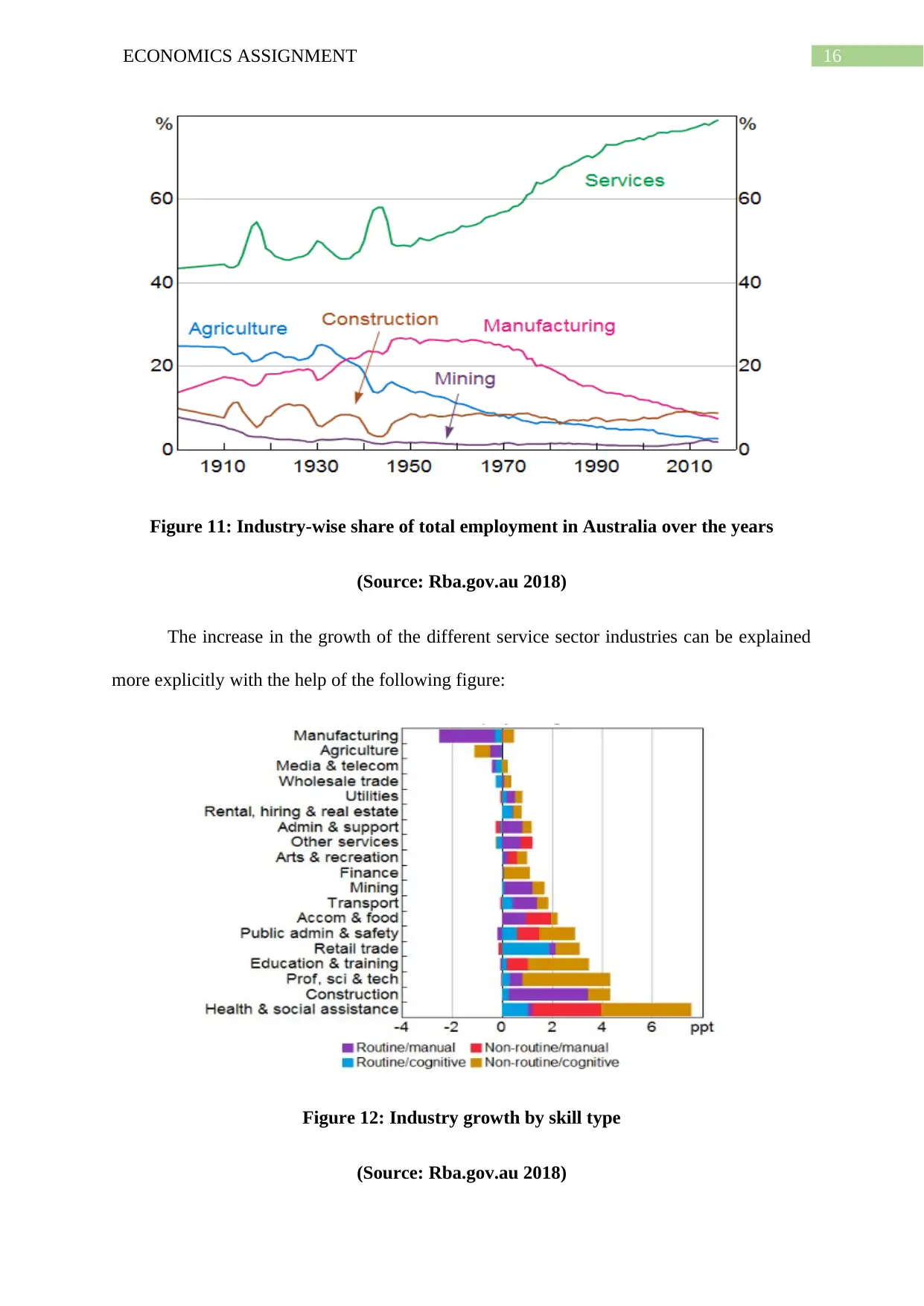
16ECONOMICS ASSIGNMENT
Figure 11: Industry-wise share of total employment in Australia over the years
(Source: Rba.gov.au 2018)
The increase in the growth of the different service sector industries can be explained
more explicitly with the help of the following figure:
Figure 12: Industry growth by skill type
(Source: Rba.gov.au 2018)
Figure 11: Industry-wise share of total employment in Australia over the years
(Source: Rba.gov.au 2018)
The increase in the growth of the different service sector industries can be explained
more explicitly with the help of the following figure:
Figure 12: Industry growth by skill type
(Source: Rba.gov.au 2018)
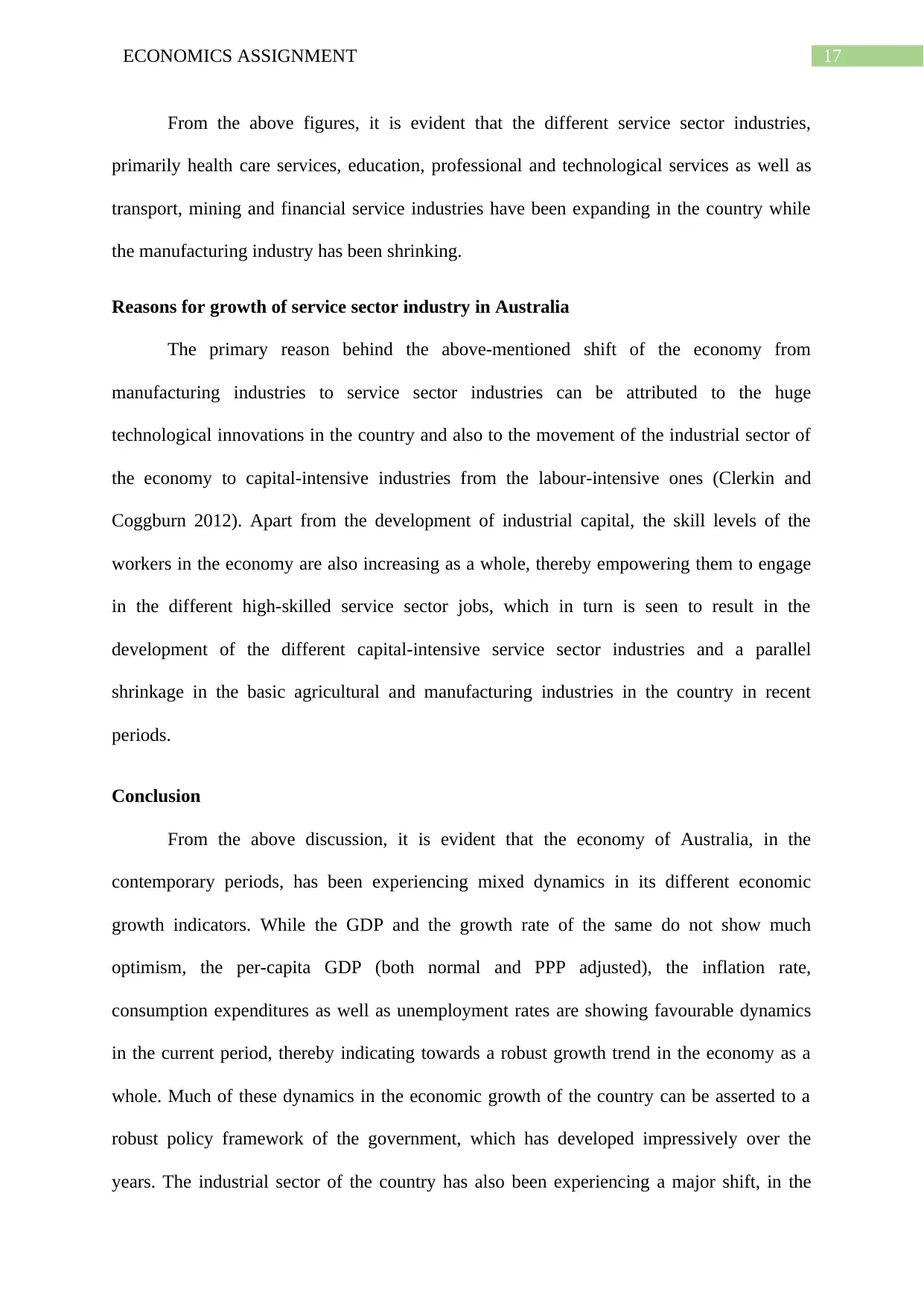
17ECONOMICS ASSIGNMENT
From the above figures, it is evident that the different service sector industries,
primarily health care services, education, professional and technological services as well as
transport, mining and financial service industries have been expanding in the country while
the manufacturing industry has been shrinking.
Reasons for growth of service sector industry in Australia
The primary reason behind the above-mentioned shift of the economy from
manufacturing industries to service sector industries can be attributed to the huge
technological innovations in the country and also to the movement of the industrial sector of
the economy to capital-intensive industries from the labour-intensive ones (Clerkin and
Coggburn 2012). Apart from the development of industrial capital, the skill levels of the
workers in the economy are also increasing as a whole, thereby empowering them to engage
in the different high-skilled service sector jobs, which in turn is seen to result in the
development of the different capital-intensive service sector industries and a parallel
shrinkage in the basic agricultural and manufacturing industries in the country in recent
periods.
Conclusion
From the above discussion, it is evident that the economy of Australia, in the
contemporary periods, has been experiencing mixed dynamics in its different economic
growth indicators. While the GDP and the growth rate of the same do not show much
optimism, the per-capita GDP (both normal and PPP adjusted), the inflation rate,
consumption expenditures as well as unemployment rates are showing favourable dynamics
in the current period, thereby indicating towards a robust growth trend in the economy as a
whole. Much of these dynamics in the economic growth of the country can be asserted to a
robust policy framework of the government, which has developed impressively over the
years. The industrial sector of the country has also been experiencing a major shift, in the
From the above figures, it is evident that the different service sector industries,
primarily health care services, education, professional and technological services as well as
transport, mining and financial service industries have been expanding in the country while
the manufacturing industry has been shrinking.
Reasons for growth of service sector industry in Australia
The primary reason behind the above-mentioned shift of the economy from
manufacturing industries to service sector industries can be attributed to the huge
technological innovations in the country and also to the movement of the industrial sector of
the economy to capital-intensive industries from the labour-intensive ones (Clerkin and
Coggburn 2012). Apart from the development of industrial capital, the skill levels of the
workers in the economy are also increasing as a whole, thereby empowering them to engage
in the different high-skilled service sector jobs, which in turn is seen to result in the
development of the different capital-intensive service sector industries and a parallel
shrinkage in the basic agricultural and manufacturing industries in the country in recent
periods.
Conclusion
From the above discussion, it is evident that the economy of Australia, in the
contemporary periods, has been experiencing mixed dynamics in its different economic
growth indicators. While the GDP and the growth rate of the same do not show much
optimism, the per-capita GDP (both normal and PPP adjusted), the inflation rate,
consumption expenditures as well as unemployment rates are showing favourable dynamics
in the current period, thereby indicating towards a robust growth trend in the economy as a
whole. Much of these dynamics in the economic growth of the country can be asserted to a
robust policy framework of the government, which has developed impressively over the
years. The industrial sector of the country has also been experiencing a major shift, in the
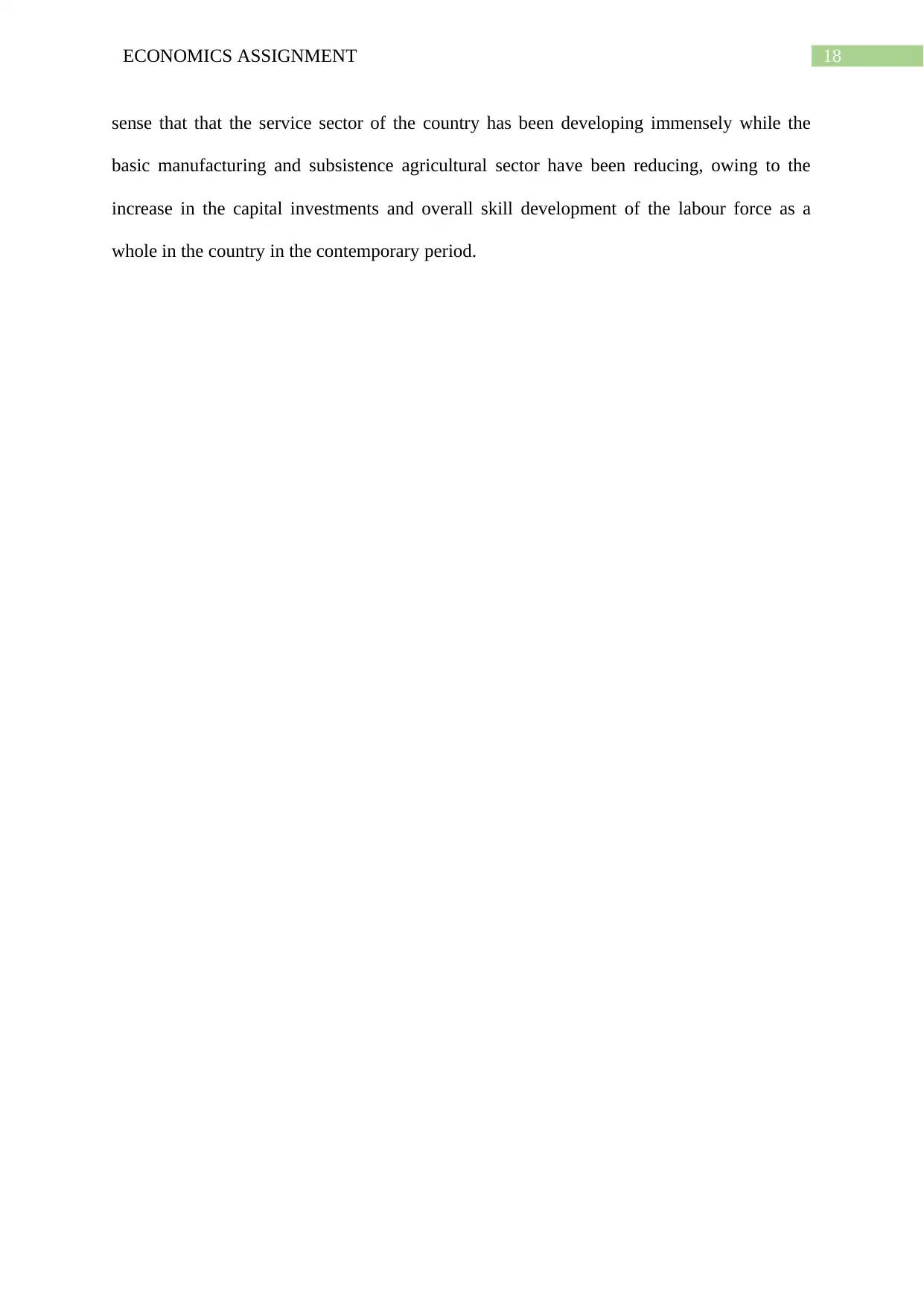
18ECONOMICS ASSIGNMENT
sense that that the service sector of the country has been developing immensely while the
basic manufacturing and subsistence agricultural sector have been reducing, owing to the
increase in the capital investments and overall skill development of the labour force as a
whole in the country in the contemporary period.
sense that that the service sector of the country has been developing immensely while the
basic manufacturing and subsistence agricultural sector have been reducing, owing to the
increase in the capital investments and overall skill development of the labour force as a
whole in the country in the contemporary period.
Paraphrase This Document
Need a fresh take? Get an instant paraphrase of this document with our AI Paraphraser

19ECONOMICS ASSIGNMENT
References
Australia, M., 2014. Compete to Prosper: Improving Australia’s global
competitiveness. Sydney Australia.
Budget.gov.au (2018). [online] Budget.gov.au. Available at: http://www.budget.gov.au/2010-
11/content/economic_statement/html/economic_statement-04.htm [Accessed 5 May
2018].
Budget.gov.au (2018). Budget 2016-17 - Sticking to our national economic plan for jobs and
growth in a stronger, new and more diversified economy. [online] Budget.gov.au.
Available at: http://budget.gov.au/2016-17/content/glossies/jobs-growth/html/
[Accessed 5 May 2018].
Butlin, N.G., 2013. Investment in Australian economic development, 1861-1900. Cambridge
University Press.
Clerkin, R.M. and Coggburn, J.D., 2012. The dimensions of public service motivation and
sector work preferences. Review of Public Personnel Administration, 32(3), pp.209-
235.
Coale, A.J. and Hoover, E.M., 2015. Population growth and economic development.
Princeton University Press.
Downes, P.M., Hanslow, K. and Tulip, P., 2014. The effect of the mining boom on the
Australian economy.
Dyster, B. and Meredith, D., 2012. Australia in the global economy: continuity and change.
Cambridge University Press.
References
Australia, M., 2014. Compete to Prosper: Improving Australia’s global
competitiveness. Sydney Australia.
Budget.gov.au (2018). [online] Budget.gov.au. Available at: http://www.budget.gov.au/2010-
11/content/economic_statement/html/economic_statement-04.htm [Accessed 5 May
2018].
Budget.gov.au (2018). Budget 2016-17 - Sticking to our national economic plan for jobs and
growth in a stronger, new and more diversified economy. [online] Budget.gov.au.
Available at: http://budget.gov.au/2016-17/content/glossies/jobs-growth/html/
[Accessed 5 May 2018].
Butlin, N.G., 2013. Investment in Australian economic development, 1861-1900. Cambridge
University Press.
Clerkin, R.M. and Coggburn, J.D., 2012. The dimensions of public service motivation and
sector work preferences. Review of Public Personnel Administration, 32(3), pp.209-
235.
Coale, A.J. and Hoover, E.M., 2015. Population growth and economic development.
Princeton University Press.
Downes, P.M., Hanslow, K. and Tulip, P., 2014. The effect of the mining boom on the
Australian economy.
Dyster, B. and Meredith, D., 2012. Australia in the global economy: continuity and change.
Cambridge University Press.
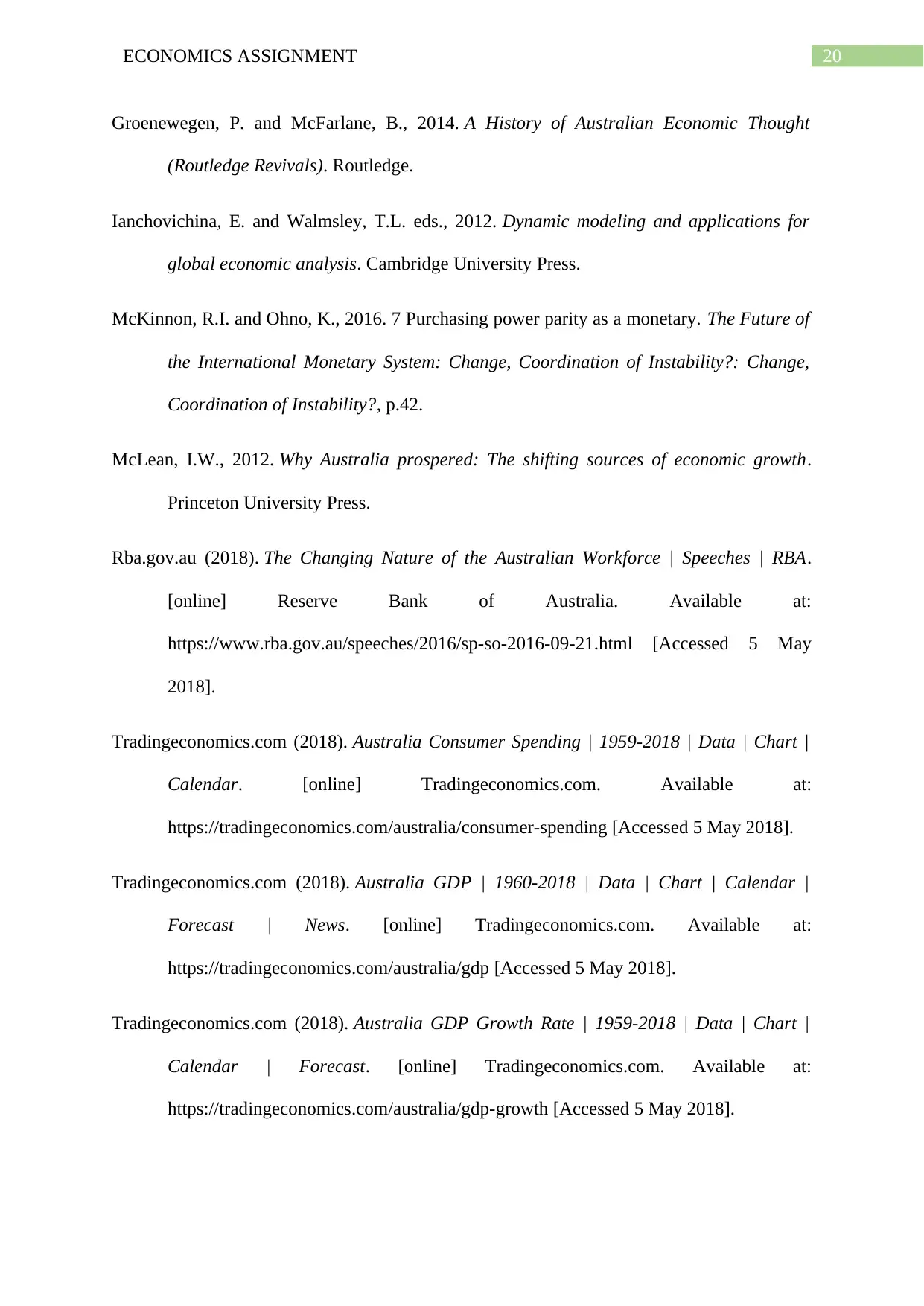
20ECONOMICS ASSIGNMENT
Groenewegen, P. and McFarlane, B., 2014. A History of Australian Economic Thought
(Routledge Revivals). Routledge.
Ianchovichina, E. and Walmsley, T.L. eds., 2012. Dynamic modeling and applications for
global economic analysis. Cambridge University Press.
McKinnon, R.I. and Ohno, K., 2016. 7 Purchasing power parity as a monetary. The Future of
the International Monetary System: Change, Coordination of Instability?: Change,
Coordination of Instability?, p.42.
McLean, I.W., 2012. Why Australia prospered: The shifting sources of economic growth.
Princeton University Press.
Rba.gov.au (2018). The Changing Nature of the Australian Workforce | Speeches | RBA.
[online] Reserve Bank of Australia. Available at:
https://www.rba.gov.au/speeches/2016/sp-so-2016-09-21.html [Accessed 5 May
2018].
Tradingeconomics.com (2018). Australia Consumer Spending | 1959-2018 | Data | Chart |
Calendar. [online] Tradingeconomics.com. Available at:
https://tradingeconomics.com/australia/consumer-spending [Accessed 5 May 2018].
Tradingeconomics.com (2018). Australia GDP | 1960-2018 | Data | Chart | Calendar |
Forecast | News. [online] Tradingeconomics.com. Available at:
https://tradingeconomics.com/australia/gdp [Accessed 5 May 2018].
Tradingeconomics.com (2018). Australia GDP Growth Rate | 1959-2018 | Data | Chart |
Calendar | Forecast. [online] Tradingeconomics.com. Available at:
https://tradingeconomics.com/australia/gdp-growth [Accessed 5 May 2018].
Groenewegen, P. and McFarlane, B., 2014. A History of Australian Economic Thought
(Routledge Revivals). Routledge.
Ianchovichina, E. and Walmsley, T.L. eds., 2012. Dynamic modeling and applications for
global economic analysis. Cambridge University Press.
McKinnon, R.I. and Ohno, K., 2016. 7 Purchasing power parity as a monetary. The Future of
the International Monetary System: Change, Coordination of Instability?: Change,
Coordination of Instability?, p.42.
McLean, I.W., 2012. Why Australia prospered: The shifting sources of economic growth.
Princeton University Press.
Rba.gov.au (2018). The Changing Nature of the Australian Workforce | Speeches | RBA.
[online] Reserve Bank of Australia. Available at:
https://www.rba.gov.au/speeches/2016/sp-so-2016-09-21.html [Accessed 5 May
2018].
Tradingeconomics.com (2018). Australia Consumer Spending | 1959-2018 | Data | Chart |
Calendar. [online] Tradingeconomics.com. Available at:
https://tradingeconomics.com/australia/consumer-spending [Accessed 5 May 2018].
Tradingeconomics.com (2018). Australia GDP | 1960-2018 | Data | Chart | Calendar |
Forecast | News. [online] Tradingeconomics.com. Available at:
https://tradingeconomics.com/australia/gdp [Accessed 5 May 2018].
Tradingeconomics.com (2018). Australia GDP Growth Rate | 1959-2018 | Data | Chart |
Calendar | Forecast. [online] Tradingeconomics.com. Available at:
https://tradingeconomics.com/australia/gdp-growth [Accessed 5 May 2018].
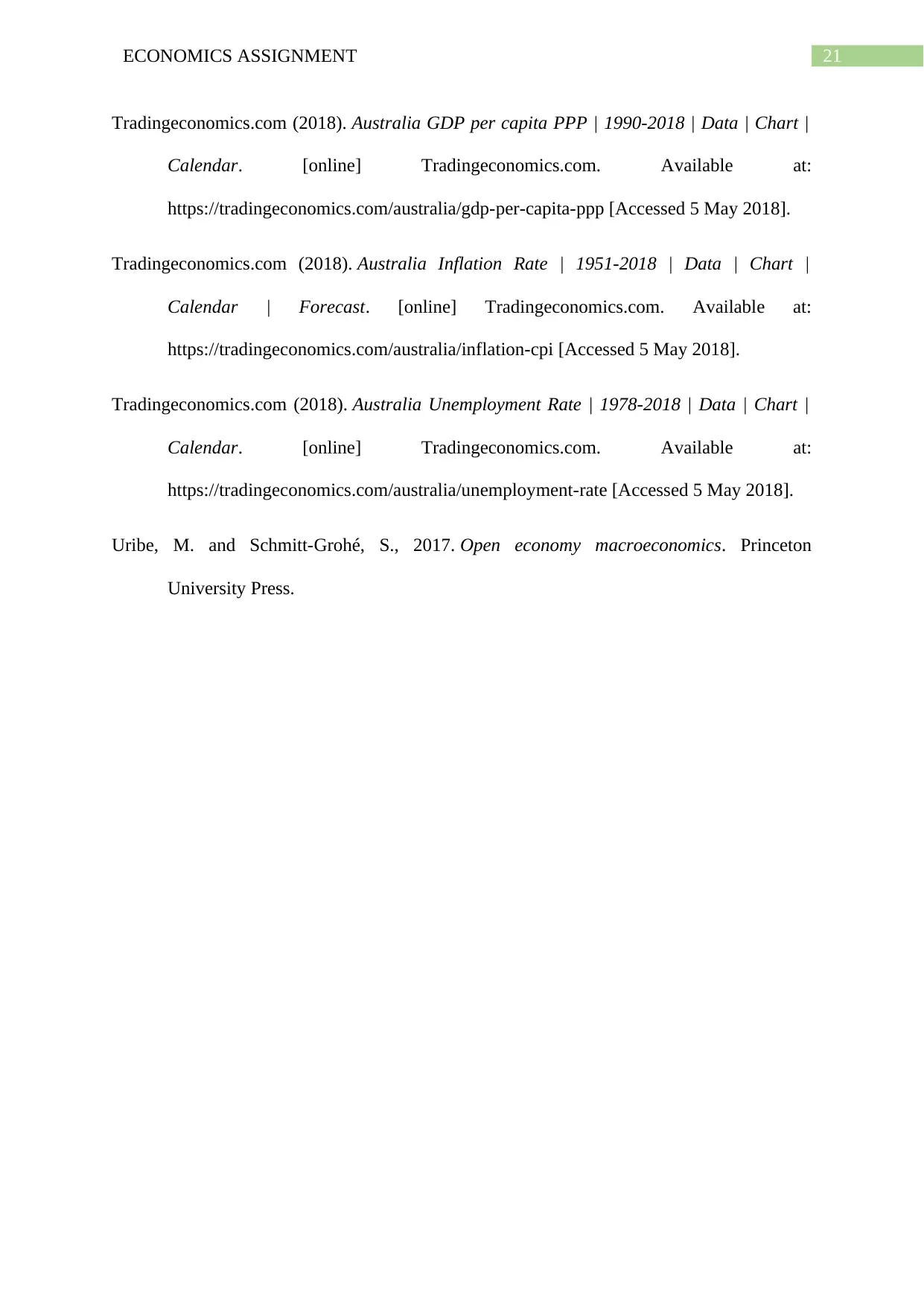
21ECONOMICS ASSIGNMENT
Tradingeconomics.com (2018). Australia GDP per capita PPP | 1990-2018 | Data | Chart |
Calendar. [online] Tradingeconomics.com. Available at:
https://tradingeconomics.com/australia/gdp-per-capita-ppp [Accessed 5 May 2018].
Tradingeconomics.com (2018). Australia Inflation Rate | 1951-2018 | Data | Chart |
Calendar | Forecast. [online] Tradingeconomics.com. Available at:
https://tradingeconomics.com/australia/inflation-cpi [Accessed 5 May 2018].
Tradingeconomics.com (2018). Australia Unemployment Rate | 1978-2018 | Data | Chart |
Calendar. [online] Tradingeconomics.com. Available at:
https://tradingeconomics.com/australia/unemployment-rate [Accessed 5 May 2018].
Uribe, M. and Schmitt-Grohé, S., 2017. Open economy macroeconomics. Princeton
University Press.
Tradingeconomics.com (2018). Australia GDP per capita PPP | 1990-2018 | Data | Chart |
Calendar. [online] Tradingeconomics.com. Available at:
https://tradingeconomics.com/australia/gdp-per-capita-ppp [Accessed 5 May 2018].
Tradingeconomics.com (2018). Australia Inflation Rate | 1951-2018 | Data | Chart |
Calendar | Forecast. [online] Tradingeconomics.com. Available at:
https://tradingeconomics.com/australia/inflation-cpi [Accessed 5 May 2018].
Tradingeconomics.com (2018). Australia Unemployment Rate | 1978-2018 | Data | Chart |
Calendar. [online] Tradingeconomics.com. Available at:
https://tradingeconomics.com/australia/unemployment-rate [Accessed 5 May 2018].
Uribe, M. and Schmitt-Grohé, S., 2017. Open economy macroeconomics. Princeton
University Press.
1 out of 22
Related Documents
Your All-in-One AI-Powered Toolkit for Academic Success.
+13062052269
info@desklib.com
Available 24*7 on WhatsApp / Email
![[object Object]](/_next/static/media/star-bottom.7253800d.svg)
Unlock your academic potential
© 2024 | Zucol Services PVT LTD | All rights reserved.





